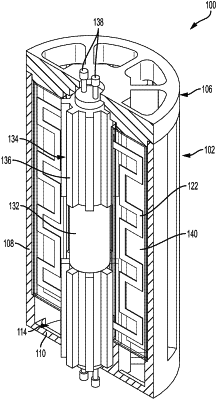| CPC C01B 3/0042 (2013.01) [C01B 3/0005 (2013.01); C01B 3/0084 (2013.01); C01B 6/04 (2013.01); F17C 11/005 (2013.01); Y02E 60/32 (2013.01)] | 22 Claims |

|
1. A hydrogen storage assembly, comprising:
a housing;
a central electrical busbar supported by the housing and positioned generally along a central axis of the assembly;
at least one wafer formed of a substrate material that produces metal hydride when exposed to a hydrogen-rich carrier fluid, the at least one wafer supported by the housing and arranged so that the hydrogen-rich carrier fluid can flow over a reaction surface of the at least one wafer; and
at least one heating element arranged to transfer heat to the at least one wafer to attain an operating temperature suitable for hydrogen charging on the reaction surface, the at least one heating element comprising a plurality of electrical heating elements connected to and spaced about the central electrical busbar.
|
|
13. A method of storing hydrogen, comprising:
providing a hydrogen storage assembly comprising a plurality of wafers formed of a substrate material that produces metal hydride when exposed to a hydrogen-rich carrier fluid, the plurality of wafers each comprising a reaction surface and a de-activation material on the reaction surface;
transferring heat to the plurality of wafers to attain an operating temperature suitable for hydrogen charging on the reaction surfaces;
flowing the hydrogen-rich carrier fluid over the plurality of wafers so as to charge hydrogen on the reaction surfaces, thereby storing hydrogen in the hydrogen storage assembly; and
maintaining the operating temperature at about 250° C. or less.
|